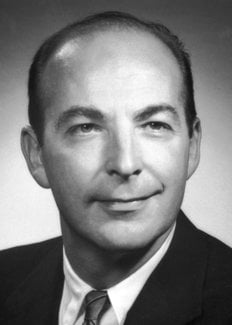Arthur Kornberg
Biographical

Arthur Kornberg was born in Brooklyn, New York in 1918 and educated in its public schools. He received his undergraduate degree in science from the City College of New York in 1937 and the M.D. degree from the University of Rochester in 1941. After a year’s internship in internal medicine, he served as a commissioned officer in the U.S. Public Health Service. He was first assigned to the Navy as a ship’s doctor, and then as a research scientist at the National Institutes of Health (NIH) in Bethesda, Maryland, from 1942 to 1953. He obtained training in enzymology with Professor Severo Ochoa at New York University School of Medicine in 1946 and with Professor Carl Cori at Washington University School of Medicine in 1947. Upon returning to Bethesda, he organized and directed the Enzyme Section. He resigned in 1953 with the rank of Medical Director, to assume the chairmanship of the Department of Microbiology of Washington University School of Medicine in St. Louis, Missouri. In 1959, he organized the Department of Biochemistry of the Stanford University School of Medicine, serving as its chairman until 1969 and thereafter as professor. He accepted the title of Professor Emeritus in 1988 and has been on active status to the present. The members of the Stanford Biochemistry Department – Robert Baldwin, Paul Berg, David Hogness, Dale Kaiser, Arthur Kornberg and Robert Lehman – stayed together as a cohesive unit for forty years until retirement.
From his early studies of the mechanisms of the enzymatic synthesis of coenzymes and inorganic pyrophosphate, he extended his interest to the biosynthesis of the nucleic acids, particularly DNA. After elucidating key steps in the pathways of pyrimidine and purine nucleotide synthesis, including the discovery of PRPP as an intermediate, he found the enzyme that assembles the building blocks into DNA, named DNA polymerase. This ubiquitous class of enzymes make genetically precise DNA and are essential in the replication, repair and rearrangements of DNA. Many other enzymes of DNA metabolism were discovered responsible for the start and elongation of DNA chains and chromosomes. These enzymes were the basis of discovery of recombinant DNA which helped ignite the biotechnology revolution.
Since 1991, he switched his research focus from DNA replication to inorganic polyphosphate (poly P), a polymer of phosphates that likely participated in prebiotic evolution and is now found in every bacterial, plant and animal cell. Neglected and long regarded a molecular fossil, he has found a variety of significant functions for poly P that include responses to stresses and stringencies and factors responsible for motility and virulence in some of the major pathogens.
Although the pursuit of research has been his primary concern, other interests include the formal teaching of graduate, medical and postdoctoral students, and the authorship of major monographs: DNA Synthesis in 1974, DNA Replication in 1980, Supplement to DNA Replication in 1982, and DNA Replication, Second Edition, in 1992. A scientific autobiography, For the Love of Enzymes: The Odyssey of a Biochemist, Harvard University Press, appeared in 1989. The Golden Helix: Inside Biotech Ventures, University Science Books, was released in July of 1995, and provides an insider’s view of biotechnology.
In his academic career, he has served as departmental chairman, on the committees of the Medical School and university, as president of the American Society of Biological Chemistry (1965), and on the advisory boards and councils of numerous university, governmental and industrial research institutes. He is a founder of the DNAX Research Institute of Molecular and Cellular Biology (a Division of Schering-Plough, Inc.), and a member of its Policy and Scientific Advisory Boards. He serves on the Scientific Advisory Boards of Regeneron Pharmaceuticals, Inc., Maxygen, and the XOMA Corp., and is also a member of the Board of Directors of XOMA Corp.
Among his honors are memberships in the National Academy of Sciences, the Royal Society, American Philosophical Society, a number of honorary degrees, the Nobel Prize in Physiology or Medicine (1959), the National Medal of Science (1979), the Cosmos Club Award (1995) and other medals and awards.
He was married in 1943 to Sylvy Ruth Levy, who died in 1986. He has three sons and eight grandchildren. Roger is a Professor of Structural Biology at Stanford; Thomas is a Professor of Biochemistry and Biophysics at the University of California in San Francisco; Kenneth is an architect and founder of Kornberg Associates in Menlo Park and Delmar, California, specializing in laboratory design. In 1988 he married Charlene Walsh Levering, who died in September of 1995. In 1998 he married Carolyn Frey Dixon. Dr. Kornberg resides in Portola Valley, California. He enjoys tennis, travel, music, and time with his family.
* This autobiography was provided by the Laureate in April 2005.
Arthur Kornberg died on October 26, 2007.
Nobel Prizes and laureates
Six prizes were awarded for achievements that have conferred the greatest benefit to humankind. The 14 laureates' work and discoveries range from quantum tunnelling to promoting democratic rights.
See them all presented here.
